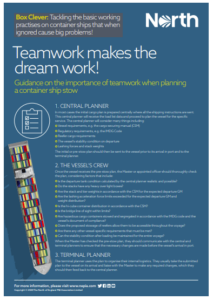The North of England P&I Club shared guidance on the importance of teamwork when planning a container ship stow, addressing basic working practices on container ships that when ignored cause big problems.
1.Central Planner
In most cases the initial cargo plan is prepared centrally where all the shipping instructions are sent. This central planner will receive the load list data and proceed to plan the vessel for the specific service. The central planner will consider many things including:
- Vessel requirements, e.g. the cargo securing manual (CSM)
- Regulatory requirements, e.g. the IMDG Code
- Reefer cargo requirements
- The vessel’s stability condition on departure
- Lashing forces and stack weights
- The initial or pre-stow plan should then be sent to the vessel prior to its arrival in port and to the terminal planner.
2.The vessel’s crew
Once the vessel receives the pre-stow plan, the Master or appointed officer should thoroughly check the plan, considering factors that include:
- Is the departure tank condition calculated by the central planner realistic and possible?
- Do the stacks have any heavy over light boxes?
- Are the stack and tier weights in accordance with the CSM for the expected departure GM?
- Are the lashing acceleration force limits exceeded for the expected departure GM and weight distribution?
- Is the hi-cube container distribution in accordance with the CSM?
- Is the bridge line of sight within limits?
- Are hazardous cargo containers stowed and segregated in accordance with the IMDG code and the vessel’s document of compliance?
- Does the proposed stowage of reefers allow them to be accessible throughout the voyage?
- Are there any other vessel-specific requirements that must be met?
- Can the stability condition after loading be maintained for the entire voyage?
When the Master has checked the pre-stow plan, they should communicate with the central and terminal planners to ensure that the necessary changes are made before the vessel’s arrival in port.
3.Terminal Planner
The terminal planner uses the plan to organize their internal logistics. They usually take the submitted plan to the vessel on its arrival and liaise with the Master to make any required changes, which they should then feed back to the central planner.
These three parties must communicate to ensure the plan is safe and executed correctly. The central planner will potentially be planning several vessels at the same time and therefore errors could occur. The vessel’s crew and the terminal planner must play their part to ensure that any issues are identified and resolved. If one member of the team fails to fully check the plan, then problems will occur!,
…North Club said.
The guidance follows an alarming trend of container ship fires in the last years. In September, a consortium of five partners issued a guide to serve as a route-map for the CTU Code and to assist wider understanding of good packing practices.
Find more herebelow:


































































